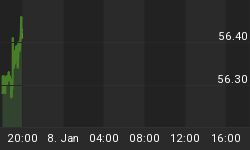
A rising tide lifts all boats - is certainly the aphorism of choice looking at the series of correlation studies from the market-data aficionado David Stendahl. David's most recent data nugget presents various asset correlations to the S&P 500 Index from the beginning of the second quarter of 2000. A few things to keep in mind with regards to the data.
- Each correlation study is based on the market's % monthly return figure and not price.
- The dark line plots the 24 month rolling correlation from early 2000 to current month.
- The lighter lines plot dynamic high/low correlation levels that adjust to current market conditions.
- A correlation of +1 signifies a direct relationship while a correlation of -1 signifies an inverse relationship.
For anyone remotely connected to the markets over the past several years, the idea that the markets have been strongly trending (and inversely correlating) together should come as no surprise. With that said, it is always welcomed to see the data presented in chart-form to flesh out a bit of the more discrete nuance.
Currencies




Commodities



Foreign Equity



Some quick takeaways from the data. Notice how tight the high/low bands have squeezed since September (start of QE2) of last year - specifically in the currency markets. The Canadian dollar and the euro have actually recently traded outside of the band - similar to last September. The same dynamic utilized by traders with regards to bollinger bands in anticipating transitions from low to high volatility environments would apply to these studies. For the dollar - it is the tightest spread since early 2002. The respective foreign equity markets have already broken down away from strengthening correlations with the S&P 500.
Collectively, these assets have strengthened their respective correlations (and inverse correlation) since the end of the first quarter in 2007. Interestingly, and as alluded in my previous notes - that also marks the ignition point for the financial crisis.
More to come in this line of thinking. I am still away at the shore with my family - but felt compelled to share.
To see the actual data - visit David's site, the Signal Financial Group (here).
















